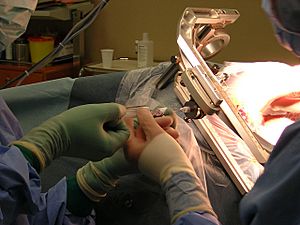Biopsy facts for kids

A biopsy is a special medical test. Doctors use it to learn more about what's happening inside your body. They carefully take a tiny sample of cells or tissue. Then, they look at this sample very closely under a powerful microscope. Sometimes, they also do special chemical tests on it. This helps them find out if there's an illness or a problem, like an infection or something else that needs treatment.
Contents
What Does "Biopsy" Mean?
The word "biopsy" comes from ancient Greek words. It combines bio, which means "life," and opsia, which means "to see." So, a biopsy literally means "to see life" or "to look at living tissue."
Why Do Doctors Do a Biopsy?
Doctors do biopsies for many important reasons. The main goal is to figure out exactly what is causing a health problem. It helps them make a correct diagnosis.
Finding Out What's Wrong
- Diagnosing illnesses: A biopsy can confirm if someone has a specific illness. For example, it can help identify if a lump is harmless or if it needs more treatment.
- Checking for infections: Sometimes, a biopsy can show if an area of the body has an infection that isn't getting better.
- Understanding inflammation: It can also help doctors understand why a part of the body is swollen or irritated. This is called inflammation.
Planning Treatment
Once a diagnosis is made, the biopsy results help doctors plan the best way to help you. They can decide what kind of medicine or other treatments might be needed. It helps them choose the most effective path for your health.
How Is a Biopsy Done?
There are different ways doctors can take a biopsy sample. The method they choose depends on where the sample needs to be taken from. It also depends on the type of tissue they need to examine.
Needle Biopsy
A common type is a needle biopsy. For this, doctors use a very thin, hollow needle. They guide the needle to the right spot, often using ultrasound or CT scans to see inside the body. The needle then collects a small piece of tissue. This method is often used for organs like the liver or kidney.
Surgical Biopsy
Sometimes, a small operation, or surgical biopsy, is needed. A doctor might make a small cut to remove a larger piece of tissue. This can be done if the area is hard to reach with a needle. It might also be done if a bigger sample is needed for testing.
Skin Biopsy
If there's a suspicious spot on the skin, a skin biopsy might be done. This usually involves removing a tiny piece of skin. It's often done with a special tool that takes a small circle of tissue.
Bone Marrow Biopsy
A bone marrow biopsy is used to check the bone marrow. This is the spongy tissue inside some bones where blood cells are made. A needle is used to take a sample, usually from the hip bone.
Endoscopic Biopsy
For areas inside the body, like the stomach or intestine, an endoscopic biopsy is used. A doctor uses a long, thin tube with a camera on the end, called an endoscope. This tube is gently put into the body, and tiny tools on the end can take a sample.
What Happens After a Biopsy?
After the sample is taken, it goes to a special lab. Here, experts called pathologists prepare the tissue. They slice it very thinly and put it on glass slides.
Looking Under the Microscope
The pathologist then looks at these slides under a powerful microscope. They search for any unusual cells or signs of illness. They might also do special chemical tests on the sample. These tests can help identify specific types of cells or problems.
Getting the Results
Once the pathologist has finished their examination, they write a report. This report explains what they found in the sample. Your doctor will then use this information to talk with you and decide on the next steps for your health.
Is a Biopsy Painful?
Doctors usually give you medicine to numb the area where the biopsy will be taken. This is called a local anesthetic. It helps make the procedure as comfortable as possible. You might feel some pressure or a dull ache, but it shouldn't be very painful. After the numbing medicine wears off, you might feel a little sore for a short time.
Images for kids
-
Lung biopsy in a case of suspected lung cancer under control of computed tomography.
See also
 In Spanish: Biopsia para niños
In Spanish: Biopsia para niños


